
“We’ve built the world’s thinnest notebook—without sacrificing a full-size keyboard or a full-size 13-inch display,” Jobs said. “When you first see MacBook Air, it’s hard to believe it’s a high-performance notebook with a full-size keyboard and display. But it is.”
Encased in recyclable aluminium, the MacBook Air includes a built-in iSight video camera for video conferencing and a multi-touch trackpad so users can pinch, rotate and swipe images and applications. It’s powered by a 1.6 GHz or 1.8 GHz Intel Core 2 Duo processor with 4MB L2 cache, and includes (as standard features) 2GB of memory, an 80GB 1.8-inch hard drive, and the latest 802.11n Wi-Fi technology and Bluetooth 2.1.
The small size of the notebook was made possible with the help of Intel who were able to shrink the size of its processor package by 60 percent, roughly to the size of a five cent piece. However, shrinking the MacBook Air to its minuscule measurements was not a weightless endeavour according to Intel president and chief executive Paul Otellini, who spoke at the notebook’s launch.
"When we started this product, we didn't think it was possible," he said. "There were times when we sweated over it, but in time we did what we do best, which is innovate."
Its miniature size does come at the expense of some functionality though, namely in its lack of an optical DVD drive and a user replaceable battery. To redress the disc drive absence, Apple has made available an external drive. The company also contends that the notebook’s lack of a disc drive is compensated by its wireless capabilities, which can be used to stream CDs and DVDs from another Mac.
The MacBook Air will be released in Australia in February and will cost $2,499.
Jobs also launched a video rental service on iTunes, introduced a backup appliance called Time Capsule, software upgrades for the iPhone, iPod Touch, and Apple TV at Macworld.



_(20).jpg&h=140&w=231&c=1&s=0)
.png&h=140&w=231&c=1&s=0)
_(22).jpg&h=140&w=231&c=1&s=0)



_(26).jpg&w=100&c=1&s=0)

 iTnews Executive Retreat - Security Leaders Edition
iTnews Executive Retreat - Security Leaders Edition










_(1).jpg&h=140&w=231&c=1&s=0)



